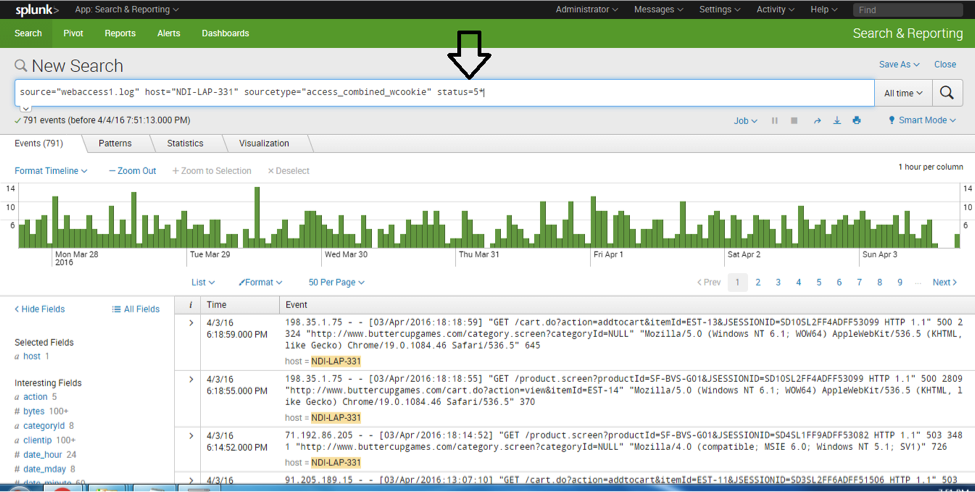

# Using the by clause, split the Logins by clientip.

Index=main sourcetype=access_combined_wcookie | stats dc(JSESSIONID) # Use search terms with the stats dc function to count all sessions (JSESSIONID)that have been used in our web application data Index=main sourcetype=access_combined_wcookie file=success.do OR file=cart.do status=200 | stats count as Transactions by file | rename file as Function # Using the rename command, change the name of the file field to Function. Index=main sourcetype=access_combined_wcookie file=success.do OR file=cart.do status=200 | stats count as Transactions by file

Use an as clause to rename the column to Transactions. # Notice that the count column is labeled count by default. Index=main sourcetype=access_combined_wcookie file=success.do OR file=cart.do status=200 | stats # Use the stats count function with a by clause to count events by the file that was served /tutorial/splunk/labs/fundamental/Splunk_f1_Data.zip index=main sourcetype=access_combined_wcookie file=success.do OR file=cart.do status=200
#Splunk stats earliest download#
Sample Data - Download sample data for lab. Use the count function of the stats command to find out how many items were added to a cart The eval command creates new fields in your events by using existing fields and an arbitrary expression. The stats command calculates statistics based on fields in your events. Difference between stats and eval commands If a BY clause is used, one row is returned for each distinct value specified in the BY clause. If the stats command is used without a BY clause, only one row is returned, which is the aggregation over the entire incoming result set. Can i assume it works similarly for future time as well _time+900Ĭould you please help me if i framed query in right fashion w.r.Stats: Splunk Commands Tutorials & Reference Commands Category: Filtering Commands: stats Use: Calculates aggregate statistics,such as average, count, and sum, over the results set. Though i need in future, currently i am checking back in time _time-900. > My query seems to be going into queue & after sometime, i get 0 matches. > As i don't future logs handy yet, i was looking back on a random log by hardcoding it in subsearch. | eventstats values(isThereAEventAfter) as isThereAEventAfter | map maxsearches=20000 search='search earliest=\"$a_earliest$\" latest=\"$a_latest$\" \"consistent with item=$pid$, on Date=$Dt$\" | stats count | eval isThereAEventBefore=if(count>0, 1, 0)' | eval pid=itemId, dt=ItemDate, a_latest=_time+900, a_earliest=_time So it felt like i need a map instead of append, below is a sample query: > and doesn't run a subsearch for every event faced in outer query. This is to filter out some false positives in logs. I would like to flag a splunk record(X) when there exists certain splunk record(Y) in +15mins(future) w.r.t event time of X. Here is the quick description of use case: | eval is_before = if((now() - relative_time(now, "-1h")) 0, 1, 0)Īpologies for not posting query clearly, i was little confused with my usecase & new to splunk as well. Assuming "earliest=-1h" is still the correct logic for isThereAEventBefore, app=my-app "found x=*$ on day1" earliest=-2h ``` 2h is just an example any value greater than 1h will do ``` You do a broader search to include both index queries, then mark events to separate, perform stats on one set, then filter out that set that you only need for stats. You can get away from a single index search with no append in order to improve performance. In this, both append and eventstats are expensive, especially considering the subsearch is so close to the main search. | eventstats values(isThereAEventBefore) as isThereAEventBefore | eval isThereAEventBefore = if(count > 0, 1, 0)] [search app=my-app "found x=*$ on day1" earliest=-1h Here is a literal way to implement my speculation of your intention. Because you didn't say what was the search period of the first search, I also suspect that if the field you wanted is isThereAEventBefore (as oppsosed to isThereAEvent After), earliest should be latest. It is more probable that your desired second search contains ("found x=*$ on day1" earliest=-1h) instead of ("found x=*$ on day1 earliest=-1h").

(Additionally, the second search which you enclose in parentheses also contains a misplaced quotation mark.
#Splunk stats earliest code#
The illustrated pseudo code is not how SPL works. If I understand correctly, you are trying to inject a field isThereAEventBefore based on what you call a subquery when that query returns a count greater than 0, set isThereAEventBefore to 1, otherwise set to 0. When your code/pseudo code is already giving error or undesired output, it is best to describe the use case/intention/desire in words.


 0 kommentar(er)
0 kommentar(er)
